Churchill war ministry
The Churchill war ministry was the United Kingdom's coalition government for most of the Second World War from 10 May 1940 to 23 May 1945. It was led by Winston Churchill, who was appointed Prime Minister by King George VI following the resignation of Neville Chamberlain in the aftermath of the Norway Debate.
| Churchill war ministry | |
|---|---|
| 1940–1945 | |
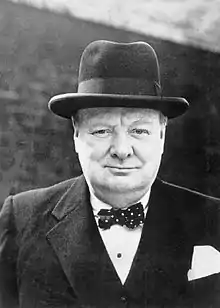 Winston Churchill on 2 August 1944 | |
| Date formed | 10 May 1940 |
| Date dissolved | 23 May 1945 |
| People and organisations | |
| Monarch | George VI |
| Prime Minister | Winston Churchill |
| Deputy Prime Minister | Clement Attlee (1942–1945) |
| Total no. of members | 223 appointments |
| Member parties | |
| Status in legislature | Majority (coalition) |
| History | |
| Legislature term(s) | 37th UK Parliament |
| Incoming formation | Norway Debate |
| Predecessor | Chamberlain war ministry |
| Successor | Churchill caretaker ministry |
At the outset, Churchill formed a five-man War Cabinet which included Chamberlain as Lord President of the Council, Clement Attlee as Lord Privy Seal and later as Deputy Prime Minister, Viscount Halifax as Foreign Secretary and Arthur Greenwood as a minister without portfolio. Although the original war cabinet was limited to five members, in practice they were augmented by the service chiefs and ministers who attended the majority of meetings. The cabinet changed in size and membership as the war progressed but there were significant additions later in 1940 when it was increased to eight after Churchill, Attlee and Greenwood were joined by Ernest Bevin as Minister of Labour and National Service; Anthony Eden as Foreign Secretary – replacing Halifax, who was sent to Washington D.C. as ambassador to the United States; Lord Beaverbrook as Minister of Aircraft Production; Sir Kingsley Wood as Chancellor of the Exchequer and Sir John Anderson as Lord President of the Council – replacing Chamberlain who died in November (Anderson later became Chancellor after Wood's death in September 1943).
The coalition was dissolved in May 1945, following the final defeat of Germany, when the Labour Party decided to withdraw in order to prepare for a general election. Churchill, who was the leader of the Conservative Party, was asked by the King to form a new, essentially Conservative, government. It was known as the Churchill caretaker ministry and managed the country's affairs until completion of the general election on 26 July that year.
Background
The 1935 general election had resulted in a Conservative victory with a substantial majority and Stanley Baldwin became Prime Minister. In May 1937, Baldwin retired and was succeeded by Neville Chamberlain who continued Baldwin's foreign policy of appeasement in the face of German, Italian and Japanese aggression. Having signed the Munich Agreement with Hitler in 1938, Chamberlain became alarmed by the dictator's continuing aggression and, in March 1939, signed the Anglo-Polish military alliance which supposedly guaranteed British support for Poland if attacked. Chamberlain issued the declaration of war against Germany on 3 September 1939 and formed a war cabinet which included Winston Churchill (out of office since June 1929) as First Lord of the Admiralty.[1]
Dissatisfaction with Chamberlain's leadership became widespread in the spring of 1940 after Germany successfully invaded Norway. In response, the House of Commons held the Norway Debate from 7 to 9 May. At the end of the second day, the Labour opposition forced a division which was in effect a motion of no confidence in Chamberlain. The government's majority of 213 was reduced to 81, still a victory but nevertheless a shattering blow for Chamberlain.[2]
9–13 May 1940: Creation of a new government
9 May – Chamberlain considers his options

On Thursday, 9 May, Chamberlain attempted to form a National Coalition Government. In talks at Downing Street with Viscount Halifax and Churchill, he indicated that he was quite ready to resign if that was necessary for Labour to enter such a government. Labour's leader Clement Attlee and his deputy Arthur Greenwood then joined the meeting, and when asked, they indicated that they must first consult their party's National Executive Committee (then in Bournemouth to prepare for the annual conference), but it was unlikely they could serve in a government led by Chamberlain; they probably would be able to serve under some other Conservative.[3]
After Attlee and Greenwood left, Chamberlain asked whom he should recommend to the King as his successor. The version of events given by Churchill is that Chamberlain's preference for Halifax was obvious (Churchill implies that the spat between Churchill and the Labour benches the previous night had something to do with that); there was a long silence which Halifax eventually broke by saying he did not believe he could lead the government effectively as a member of the House of Lords instead of the House of Commons.[4] Churchill's version gets the date wrong, and he fails to mention the presence of David Margesson, the government Chief Whip.[4][5][6]
Halifax's account omits the dramatic pause and gives an additional reason: "PM said I was the man mentioned as most acceptable. I said it would be hopeless position. If I was not in charge of the war (operations) and if I didn't lead in the House, I should be a cypher. I thought Winston was a better choice. Winston did not demur."[3] According to Halifax, Margesson then confirmed that the House of Commons had been veering to Churchill.
In a letter to Churchill written that night,[7] Bob Boothby asserted that parliamentary opinion was hardening against Halifax, claiming in a postscript that according to Liberal MP Clement Davies, "Attlee & Greenwood are unable to distinguish between the PM & Halifax and are not prepared to serve under the latter". Davies (who thought Chamberlain should go, and be replaced by Churchill) had lunched with Attlee and Greenwood (and argued his case) shortly before they saw Chamberlain.[8] Labour's Hugh Dalton, however, noted in his diary entry for 9 May that he had spoken with Attlee, who "agrees with my preference for Halifax over Churchill, but we both think either would be tolerable".[9]
10 May – Churchill succeeds Chamberlain
On the morning of Friday, 10 May, Germany invaded the Netherlands and Belgium. Chamberlain initially felt that a change of government at such a time would be inappropriate, but upon being given confirmation that Labour would not serve under him, he announced to the War Cabinet his intention to resign.[10] Scarcely more than three days after he had opened the debate, Chamberlain went to Buckingham Palace to resign as Prime Minister. Despite resigning as PM, however, he continued to be the leader of the Conservative Party. He explained to the King why Halifax, whom the King thought the obvious candidate,[11] did not want to become Prime Minister. The King then sent for Churchill and asked him to form a new government; according to Churchill, there was no stipulation that it must be a coalition government.[12]
At 21:00 on 10 May, Chamberlain announced the change of Prime Minister over the BBC. Churchill's first act as Prime Minister was to ask Attlee to come and see him at Admiralty House. Next, he wrote to Chamberlain to thank him for his promised support. He then began to construct his coalition cabinet: before he went to bed at 03:00 on Saturday, 11 May, six hours after Chamberlain's original announcement, Churchill had established the composition of the new War Cabinet and appointed the heads of the three Service Ministries.[13]
11/12 May – formation of the national government
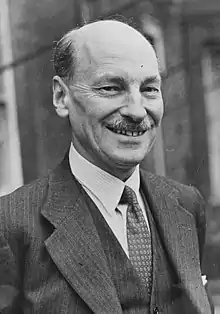
On Saturday, 11 May, the Labour Party agreed to join a national government under Churchill's leadership and he was able to form his war cabinet. In his biography of Churchill, Roy Jenkins described the Churchill cabinet as one "for winning", while the former Chamberlain cabinet was one "for losing".[14] Labour leader Clement Attlee relinquished his official role as Leader of the Opposition to become Lord Privy Seal (until 19 February 1942 when he was appointed Deputy Prime Minister). Arthur Greenwood, Labour's deputy leader, was appointed a minister without portfolio.[15]
There was no de facto Leader of the Opposition from 11 May 1940 until Attlee resumed the role on 23 May 1945. The Labour Party appointed an acting Leader of the Opposition whose job, although he was in effect a member of the national government, was to ensure the continued functionality of the House of Commons. Due process in the Commons requires someone, even a member of the government, to fill the role even if there is no actual opposition.[16] The first acting leader was Hastings Lees-Smith, the MP for Keighley, who died in office on 18 December 1941. He was briefly succeeded by Frederick Pethick-Lawrence and then by Arthur Greenwood, who had left the War Cabinet, from 22 February 1942 until 23 May 1945.[17]
The main problem for Churchill as he became Prime Minister was that he was not the leader of the majority Conservative Party and, needing its support, was obliged to include Chamberlain in the war cabinet, but this was not to Labour's liking. Initially, Churchill proposed to appoint Chamberlain as both Leader of the House of Commons and Chancellor of the Exchequer. Attlee objected and Churchill decided to appoint Chamberlain as Lord President of the Council. The fifth member of the war cabinet was Halifax, who retained his position as Foreign Secretary.[18] Instead of Chamberlain, Sir Kingsley Wood became Chancellor but, until 3 October 1940, he was not a member of the war cabinet.[19]
Churchill appointed himself as Leader of the House of Commons (it was normal procedure until 1942 for a prime minister in the Commons to lead the House) and created for himself the new role of Minister of Defence, so that he would be permanent chair of the Cabinet Defence Committee (CDC) which included the three service ministers, the three service chiefs of staff and other ministers and experts as and when required.[20][21] Anthony Eden became Secretary of State for War, Labour's A. V. Alexander succeeded Churchill as First Lord of the Admiralty and the Liberal Party leader, Sir Archibald Sinclair, became Secretary of State for Air.[22] The three service Chiefs of Staff (CoS) at this time were Admiral Sir Dudley Pound, the First Sea Lord; Air Marshal Sir Cyril Newall, the Chief of the Air Staff; and Field Marshal Sir Edmund Ironside, the Chief of the Imperial General Staff (CIGS). (On 27 May, Ironside was replaced at Churchill's request by his deputy Field Marshal Sir John Dill, and Ironside became Commander-in-Chief, Home Forces.)[23]
Of real importance to Churchill were three men who served the war cabinet and the CDC as advisors and/or secretaries. These were General Sir Hastings Ismay, Chief of Staff to the Minister of Defence; Sir Edward Bridges, Cabinet Secretary; and Major General L. C. Hollis, Secretary to the Chiefs of Staff Committee.
13 May – Churchill's first speech as Prime Minister
By Monday, 13 May, most of the senior government posts were filled. That day was Whit Monday, normally a bank holiday but cancelled by the incoming government. A specially convened sitting of the House of Commons was held and Churchill spoke for the first time as Prime Minister:[24]
I beg to move, that this House welcomes the formation of a Government representing the united and inflexible resolve of the nation to prosecute the war with Germany to a victorious conclusion.
He explained that a War Cabinet of five members had been formed to represent the unity of the nation with all three main party leaders agreeing to serve either in the War Cabinet or in high executive office. Churchill was hoping to complete all ministerial appointments by the end of the 14th. He announced an adjournment of Commons business until the 21st and apologised for making only a short address for the present. Even so, his speech has become one of his most famous because he concluded with his statement of intent:[25]
I would say to the House, as I said to those who have joined this Government: "I have nothing to offer but blood, toil, tears and sweat". We have before us an ordeal of the most grievous kind. We have before us many, many long months of struggle and of suffering. You ask, what is our policy? I will say: It is to wage war, by sea, land and air, with all our might and with all the strength that God can give us; to wage war against a monstrous tyranny never surpassed in the dark, lamentable catalogue of human crime. That is our policy. You ask, what is our aim? I can answer in one word: It is victory, victory at all costs, victory in spite of all terror, victory, however long and hard the road may be; for without victory, there is no survival. Let that be realised; no survival for the British Empire, no survival for all that the British Empire has stood for, no survival for the urge and impulse of the ages, that mankind will move forward towards its goal. But I take up my task with buoyancy and hope. I feel sure that our cause will not be suffered to fail among men. At this time I feel entitled to claim the aid of all, and I say, "Come then, let us go forward together with our united strength".
In reply, Hastings Lees-Smith as acting Leader of the Opposition announced that Labour would vote for the motion to assure the country of a unified political front.[26] After several other members had spoken, including David Lloyd George and Stafford Cripps, the House divided on the question: "That this House welcomes the formation of a Government representing the united and inflexible resolve of the nation to prosecute the war with Germany to a victorious conclusion". 381 members voted "aye" in favour of the motion and, apart from the two tellers for the "noes", the wartime coalition was endorsed unanimously.[27]
14 May 1940 to 23 May 1945
- 2 August 1940: Lord Beaverbrook, Minister of Aircraft Production, joined the War Cabinet.
- 22 September 1940: resignation of Neville Chamberlain for health reasons (terminal colon cancer).
- October 1940: Sir John Anderson succeeded Chamberlain as Lord President and joined the War Cabinet. Sir Kingsley Wood, the Chancellor of the Exchequer, and Ernest Bevin, the Minister of Labour, also entered the War Cabinet. Lord Halifax assumed the additional job of Leader of the House of Lords.
- 9 November 1940: death of Neville Chamberlain.
- 22 December 1940: Anthony Eden succeeded Lord Halifax as Foreign Secretary (Eden held the post until 26 July 1945) and joined the War Cabinet as its eighth member. Halifax became Ambassador to the United States. His successor as Leader of the House of Lords was not in the War Cabinet.
- May 1941: Beaverbrook ceased to be Minister of Aircraft Production, but remained in the War Cabinet as Minister of State. His successor was not in the War Cabinet.
- June 1941: Beaverbrook became Minister of Supply, remaining in the War Cabinet.
- 1941: Oliver Lyttelton entered the Cabinet as Minister-Resident for the Middle East.
- 4 February 1942: Lord Beaverbrook became Minister of War Production; his successor as Minister of Supply was not in the War Cabinet.
- 19 February 1942: Beaverbrook resigned and no replacement Minister of War Production was appointed for the moment. Clement Attlee became Secretary of State for Dominion Affairs and Deputy Prime Minister. Sir Stafford Cripps succeeded Attlee as Lord Privy Seal and took over the position of Leader of the House of Commons from Churchill. Sir Kingsley Wood left the War Cabinet, though remaining Chancellor of the Exchequer.
- 22 February 1942: Arthur Greenwood left the War Cabinet to assume the role of Leader of the Opposition, necessary for House of Commons functionality, till 23 May 1945.[17]
- March 1942: Oliver Lyttelton filled the vacant position of Minister of Production ("War" was dropped from the title). Richard Casey (a member of the Australian Parliament) succeeded Oliver Lyttelton as Minister-Resident for the Middle East.
- October 1942: Sir Stafford Cripps retired as Lord Privy Seal and Leader of the House of Commons and left the War Cabinet. His successor as Lord Privy Seal (Viscount Cranborne) was not in the Cabinet, Anthony Eden took the additional position of Leader of the House of Commons. The Home Secretary, Herbert Morrison, entered the Cabinet.
- 21 September 1943: death of Sir Kingsley Wood.
- September 1943: Anderson succeeded Wood as Chancellor of the Exchequer, remaining in the War Cabinet. Clement Attlee succeeded Anderson as Lord President, remaining also Deputy Prime Minister. Attlee's successor as Dominions Secretary was not in the Cabinet.
- November 1943: Lord Woolton entered the Cabinet as Minister of Reconstruction.
- January to November 1944: Lord Moyne replaced Richard Gardiner Casey as Minister-Resident for the Middle East.
23 May 1945 – End of the ministry
In October 1944, Churchill had proposed to the Commons that the current Parliament, which had begun in 1935, should be extended by a further year. He correctly anticipated the defeat of Germany in the spring of 1945 but he did not expect the end of the Far East war until 1946. He therefore recommended that the end of the European war should be "a pointer (to) fix the date of the (next) General Election".[28]
Attlee, along with Eden and others, attended the San Francisco Conference and had returned to London by 18 May 1945 (ten days after V-E Day) when he met Churchill to discuss the future of the coalition. Attlee, in agreement with Churchill, wanted it to continue until after the Japanese surrender but he discovered that others in the Labour Party, especially Morrison and Bevin, wanted an election in October after Parliament ended. On 20 May, Attlee attended his party conference and found that opinion was against him so he informed Churchill that Labour must leave the coalition.[29]
On 23 May, Labour left the coalition to begin their general election campaign. Churchill resigned as prime minister but the King asked him to form a new government, known as the Churchill caretaker ministry, until the election was held in July. Churchill agreed and his new ministry, essentially a Conservative one, held office for the next two months until it was replaced by Attlee's Labour government after their election victory.
Government members
Ministers who held War Cabinet membership, 10 May 1940 – 23 May 1945
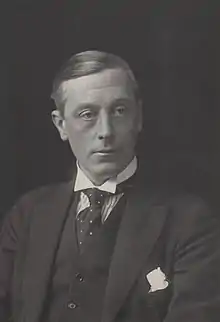
(in 1924)
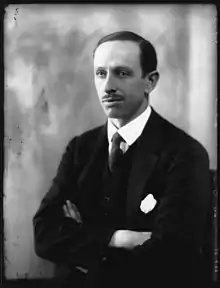
(in 1927)
This table lists those ministers who held war cabinet membership in Churchill's ministry.[30]
The focus in this table is upon the ministers themselves while the tables below are primarily concerned with ministerial offices. There were five war cabinet members at the outset and two, Churchill and Attlee, served throughout the ministry's entire term. Some members such as Bevin, Morrison and Wood were appointed to the war cabinet while retaining offices that had originally been part of the outer cabinet. Anderson and Eden were promoted to the war cabinet from other offices after their predecessors, Chamberlain and Halifax, had left the government. Others such as Beaverbrook, Lyttelton and Woolton were brought in to fill new offices that were created to address current priorities. The list includes Sir Edward Bridges, who was the Cabinet Secretary through the entire war and was rarely absent from war cabinet sessions – as a senior civil servant, he was not a political appointee and his entry below is in italics.
| Minister | Party | Portfolio | Joined war cabinet | Left war cabinet | Notes and citations | |
|---|---|---|---|---|---|---|
| Winston Churchill | Conservative | Prime Minister and First Lord of the Treasury | 10 May 1940 | 23 May 1945 | Churchill had been First Lord of the Admiralty under Neville Chamberlain and succeeded him as Prime Minister and Leader of the House. He created the new role of Minister of Defence for himself to preside over the Cabinet Defence Committee, Operations, and hold full responsibility for prosecution of the war.[31] To reduce his workload in February 1942, Churchill appointed Sir Stafford Cripps as Leader of the House.[32] | |
| Minister of Defence | 10 May 1940 | 23 May 1945 | ||||
| Leader of the House of Commons | 10 May 1940 | 19 February 1942 | ||||
| Sir Edward Bridges | none | Cabinet Secretary | 10 May 1940 | 23 May 1945 | Bridges was a civil servant who was appointed Cabinet Secretary in 1938 and remained in situ until 1946. | |
| Neville Chamberlain | Conservative | Lord President of the Council | 11 May 1940 | 29 September 1940 | Although he had resigned as Prime Minister, Chamberlain retained the leadership of the Conservative Party. He succeeded Earl Stanhope as Lord President. Chamberlain resigned for health reasons and died on 9 November 1940. He was succeeded by Home Secretary Sir John Anderson who joined the war cabinet. | |
| Clement Attlee | Labour | Lord Privy Seal | 11 May 1940 | 15 February 1942 | Attlee was the Leader of the Labour Party and relinquished the office of Leader of the Opposition for the duration. He became Deputy PM in February 1942 with general responsibility for domestic affairs.[33] Except during Attlee's tenure, Dominions was not a war cabinet portfolio (see below). | |
| Secretary of State for Dominion Affairs | 15 February 1942 | 24 September 1943 | ||||
| Deputy Prime Minister | 19 February 1942 | 23 May 1945 | ||||
| Lord President of the Council | 24 September 1943 | 23 May 1945 | ||||
| Viscount Halifax | Conservative | Foreign Secretary | 11 May 1940 | 22 December 1940 | Halifax was in situ as Foreign Secretary, having been appointed by Chamberlain on 21 February 1938. He was also briefly the Leader of the House of Lords before Churchill sent him to Washington DC as British Ambassador to the United States. He was succeeded by Anthony Eden as Foreign Secretary and by Lord Lloyd in the Lords. | |
| Leader of the House of Lords | 3 October 1940 | 22 December 1940 | ||||
| Arthur Greenwood | Labour | Minister without portfolio | 11 May 1940 | 22 February 1942 | Greenwood was the Deputy Leader of the Labour Party and a former Health Minister. He left the war cabinet in February 1942 and became acting Leader of the Opposition until 23 May 1945. | |
| Lord Beaverbrook | Conservative | Minister of Aircraft Production | 2 August 1940 | 30 April 1941 | Aircraft Production was a new office within the war cabinet that was created by Churchill to address the urgent need for military aircraft. Beaverbrook had been outside politics since 1917. He resigned on 30 April 1941 and became Minister of State which was a nominal role only with no specific portfolio. As Minister of Supply, Beaverbrook clashed with Ernest Bevin and resigned again, briefly becoming Minister of War Production before resigning for the third time. He later became Lord Privy Seal but outside the war cabinet. Except during Beaverbrook's tenures, Aircraft Production and Supply were not war cabinet portfolios (see below). | |
| Minister of State | 1 May 1941 | 29 June 1941 | ||||
| Minister of Supply | 29 June 1941 | 4 February 1942 | ||||
| Minister of War Production | 4 February 1942 | 19 February 1942 | ||||
| Sir John Anderson | National | Lord President of the Council | 3 October 1940 | 24 September 1943 | Anderson had been Home Secretary since 4 September 1939 but did not join the war cabinet until he succeeded Chamberlain as Lord President. He became Chancellor of the Exchequer in September 1943, remaining in the war cabinet. | |
| Chancellor of the Exchequer | 24 September 1943 | 23 May 1945 | ||||
| Ernest Bevin | Labour | Minister of Labour and National Service | 3 October 1940 | 23 May 1945 | Bevin had been the General Secretary of the Transport and General Workers' Union and was new to political office. Succeeding Ernest Brown, he was appointed on 13 May 1940 but did join the war cabinet until 3 October 1940. | |
| Sir Kingsley Wood | Conservative | Chancellor of the Exchequer | 3 October 1940 | 22 February 1942 | Previously Lord Privy Seal, Wood was appointed Chancellor on 12 May 1940 but did not join the war cabinet until 3 October 1940. He left the war cabinet on 22 February 1942 but remained Chancellor until his death on 21 September 1943. He was succeeded by Anderson. | |
| Anthony Eden | Conservative | Foreign Secretary | 22 December 1940 | 23 May 1945 | Eden had been the Secretary of State for War from 11 May 1940 but was outside the war cabinet until he succeeded Halifax as Foreign Secretary. In November 1942, he succeeded Cripps as Leader of the House of Commons and combined both these roles till the end of the ministry. | |
| Leader of the House of Commons | 22 November 1942 | 23 May 1945 | ||||
| Oliver Lyttelton | Conservative | Minister-Resident for the Middle East | 29 June 1941 | 12 March 1942 | Minister-Resident for the Middle East was a new war cabinet office created to relieve military commanders in the Middle East of civil responsibility. Lyttelton had been President of the Board of Trade since October 1940, but that was outside the war cabinet. He became Minister of Production (formerly War Production) and was succeeded by Richard Casey. | |
| Minister of Production | 12 March 1942 | 23 May 1945 | ||||
| Sir Stafford Cripps | Labour | Lord Privy Seal | 19 February 1942 | 22 November 1942 | Cripps had been the British Ambassador to the Soviet Union and was invited into the war cabinet in February 1942 as both Leader of the House of Commons, replacing Churchill, and Lord Privy Seal, replacing Attlee. In November 1942, he took over at Aircraft Production, which was no longer a war cabinet portfolio, until the end of the administration. | |
| Leader of the House of Commons | 19 February 1942 | 22 November 1942 | ||||
| Herbert Morrison | Labour | Home Secretary and Minister for Home Security | 22 November 1942 | 23 May 1945 | Morrison was appointed Home Secretary on 2 October 1940 but did not join the war cabinet (see below) until 22 November 1942. | |
| Richard Casey | National | Minister-Resident for the Middle East | 12 March 1942 | 14 January 1944 | Casey previously Australian Ambassador to the United States and became Governor of Bengal in January 1944. He was succeeded by Lord Moyne. | |
| Lord Woolton | National | Minister of Reconstruction | 11 November 1943 | 23 May 1945 | Reconstruction was a new war cabinet office created to lead post-war planning. Woolton had been the Minister of Food since April 1940, but that was outside the war cabinet. | |
| Lord Moyne | Conservative | Minister-Resident for the Middle East | 14 January 1944 | 6 November 1944 | Moyne had been the Deputy Minister-Resident to Casey, whom he succeeded. He was assassinated by Jewish militants on 6 November 1944. Sir Edward Grigg took over, but the portfolio was then dropped from the war cabinet. | |
Cabinet Defence Committee (CDC), Operations
Established by Churchill in May 1940, the Cabinet Defence Committee (CDC), Operations, was the key organisation through which the government prosecuted the war, especially in 1940 and 1941. From 1942, as the tide of war began to turn in favour of the Allies, the importance of the CDC was reduced and its meetings became fewer as its work was increasingly delegated or raised at conferences. Churchill created the office of Minister of Defence so that he could preside over the CDC and chair its meetings. The essential members were the three Chiefs of Staff (CoS), the three service ministers and Churchill's aide, General Ismay. Other ministers, especially Attlee, frequently attended CDC sessions, as did various experts who were summoned at need.
The CoS continued to hold their own Chiefs of Staff Committee (CSC) meetings. The CDC enabled Churchill to have direct contact with them so that strategic concerns could be addressed with due regard to civil matters and foreign affairs. This table lists the key members of the CDC.
| Portfolio | Minister | Party | Took office | Left office | Notes and citations | |
|---|---|---|---|---|---|---|
| Minister of Defence | Winston Churchill | Conservative | 10 May 1940 | 23 May 1945 | ||
| Secretary of State for War | Anthony Eden | Conservative | 11 May 1940 | 22 December 1940 | Eden had previously been the Dominions minister. In December 1940 he was promoted back to his old post as Foreign Secretary and joined the war cabinet. Margesson, the former Chief Whip, succeeded him at the War Office until he was dismissed and replaced by his Permanent Under-Secretary, James Grigg, who remained in situ till May 1945. | |
| David Margesson | Conservative | 22 December 1940 | 22 February 1942 | |||
| Sir James Grigg | National | 22 February 1942 | 23 May 1945 | |||
| Secretary of State for Air | Sir Archibald Sinclair | Liberal | 11 May 1940 | 23 May 1945 | Sinclair was the Leader of the Liberal Party and, as a close friend and ally of Churchill, he was often co-opted to the war cabinet though never an actual member. Churchill valued his support during the crisis in late May 1940. | |
| First Lord of the Admiralty | A. V. Alexander | Labour | 11 May 1940 | 23 May 1945 | Alexander was a Labour front-bench spokesman on trade. He had been First Lord from 1929 to 1931 under Ramsay MacDonald. | |
Senior government ministries and offices, 10 May 1940 – 23 May 1945
This table lists cabinet level ministries and offices during the Churchill administration.[30] Most of these were portfolios in the "outer cabinet" and outside the war cabinet, although some were temporarily included in the war cabinet, as indicated by bold highlighting of the ministers concerned.[30] Focus here is upon the ministerial offices. Some ministries, such as Foreign Secretary, were in the war cabinet throughout the entire administration whereas others like Lord Privy Seal, Chancellor of the Exchequer and Home Secretary were sometimes in the war cabinet and sometimes not, depending on priorities at the time. A number of ministries were created by Churchill in response to wartime needs. Some of the ministers retained offices that they held in former administrations and their notes include the date of their original appointment. For new appointments to existing offices, their predecessor's name is given.
| Portfolio | Minister | Party | Took office | Left office | Notes and citations | |
|---|---|---|---|---|---|---|
| Prime Minister and First Lord of the Treasury | Winston Churchill | Conservative | 10 May 1940 | 23 May 1945 | ||
| Deputy Prime Minister | Clement Attlee | Labour | 19 February 1942 | 23 May 1945 | ||
| Minister of Defence | Winston Churchill | Conservative | 10 May 1940 | 23 May 1945 | ||
| Lord Chancellor | Viscount Simon | Liberal National | 12 May 1940 | 23 May 1945 | Simon had previously been Chancellor of the Exchequer under Chamberlain and succeeded Viscount Caldecote as Lord Chancellor. In the 1940s, the Lord Chancellor presided over the House of Lords and headed the judiciary. | |
| Lord President of the Council | Neville Chamberlain | Conservative | 10 May 1940 | 29 September 1940 | ||
| Sir John Anderson | National | 3 October 1940 | 24 September 1943 | |||
| Clement Attlee | Labour | 24 September 1943 | 23 May 1945 | |||
| Lord Privy Seal | Clement Attlee | Labour | 11 May 1940 | 15 February 1942 | Attlee and Cripps were members of the war cabinet while holding this office; Cranborne and Beaverbrook were not. Cranborne, previously Secretary of State for the Colonies, was simultaneously Leader of the House of Lords and became Secretary of State for Dominion Affairs in September 1943. Beaverbrook, out of government since February 1942, succeeded Cranborne and held the tenure until the end of the administration. | |
| Sir Stafford Cripps | Labour | 19 February 1942 | 22 November 1942 | |||
| Viscount Cranborne | Conservative | 22 November 1942 | 24 September 1943 | |||
| Lord Beaverbrook | Conservative | 24 September 1943 | 23 May 1945 | |||
| Minister without portfolio | Arthur Greenwood | Labour | 11 May 1940 | 22 February 1942 | ||
| Foreign Secretary | Viscount Halifax | Conservative | 10 May 1940 | 22 December 1940 | ||
| Anthony Eden | Conservative | 22 December 1940 | 23 May 1945 | |||
| Chancellor of the Exchequer | Sir Kingsley Wood | Conservative | 12 May 1940 | 21 September 1943 | ||
| Sir John Anderson | National | 24 September 1943 | 23 May 1945 | |||
| Home Secretary and Minister for Home Security | Sir John Anderson | National | 12 May 1940 | 3 October 1940 | Anderson was in situ having been appointed by Chamberlain on 4 September 1939. He was confirmed in office by Churchill but was not invited to join the war cabinet until he succeeded Chamberlain as Lord President of the Council in October 1940. Morrison succeeded Anderson, having previously been the Minister of Supply. Morrison was appointed on 2 October 1940 but was not asked to join the war cabinet until 22 November 1942. He remained in the office and in the war cabinet until May 1945. | |
| Herbert Morrison | Labour | 2 October 1940 | 23 May 1945 | |||
| Minister of Labour and National Service | Ernest Bevin | Labour | 13 May 1940 | 23 May 1945 | ||
| Secretary of State for War | Anthony Eden | Conservative | 11 May 1940 | 22 December 1940 | ||
| David Margesson | Conservative | 22 December 1940 | 22 February 1942 | |||
| Sir James Grigg | National | 22 February 1942 | 23 May 1945 | |||
| Secretary of State for Air | Sir Archibald Sinclair | Liberal | 11 May 1940 | 23 May 1945 | ||
| First Lord of the Admiralty | A. V. Alexander | Labour | 11 May 1940 | 23 May 1945 | ||
| Leader of the House of Commons | Winston Churchill | Conservative | 10 May 1940 | 19 February 1942 | An office traditionally held by the prime minister; Churchill duly succeeded Chamberlain but later relinquished the role to reduce his workload.[32] Since then, no prime minister has taken it. | |
| Sir Stafford Cripps | Labour | 19 February 1942 | 22 November 1942 | |||
| Anthony Eden | Conservative | 22 November 1942 | 23 May 1945 | |||
| Leader of the House of Lords | Viscount Caldecote | Conservative | 10 May 1940 | 3 October 1940 | Caldecote, previously Lord Chancellor, succeeded Earl Stanhope and was simultaneously the Secretary of State for Dominion Affairs. He became Lord Chief Justice of England in October 1940 and was briefly succeeded by Halifax. The office was a war cabinet portfolio while Halifax held it. Halifax was succeeded by Lloyd who was simultaneously Secretary of State for the Colonies. Lloyd died in February 1941 and was succeeded in both offices by Moyne who had been Parliamentary Secretary to the Ministry of Agriculture and Fisheries. In February 1942, Moyne moved to Cairo as Deputy Minister-Resident and was replaced by Cranborne to the end of the administration. Besides Leader of the Lords, Cranborne successively held the offices of Secretary of State for the Colonies (to November 1942), then Lord Privy Seal (to September 1943), and then Secretary of State for Dominion Affairs to May 1945. | |
| Viscount Halifax | Conservative | 3 October 1940 | 22 December 1940 | |||
| Lord Lloyd | Conservative | 22 December 1940 | 4 February 1941 | |||
| Lord Moyne | Conservative | 8 February 1941 | 21 February 1942 | |||
| Viscount Cranborne | Conservative | 21 February 1942 | 23 May 1945 | |||
| Minister of Aircraft Production | Lord Beaverbrook | Conservative | 2 August 1940 | 30 April 1941 | A new office within the war cabinet that was created by Churchill to address the urgent need for military aircraft. Beaverbrook's successor, Moore-Brabazon, was not in the war cabinet. His anti-Soviet views obliged him to resign in February 1942 and he was succeeded by Llewellin, also outside the war cabinet. Cripps replaced Llewellin in November 1942 and held the office until May 1945. Cripps had previously been in the war cabinet as Lord Privy Seal but Aircraft Production remained an outer cabinet portfolio. | |
| John Moore-Brabazon | Conservative | 1 May 1941 | 22 February 1942 | |||
| John Llewellin | Conservative | 22 February 1942 | 22 November 1942 | |||
| Sir Stafford Cripps | Labour | 22 November 1942 | 23 May 1945 | |||
| Minister of State | Lord Beaverbrook | Conservative | 1 May 1941 | 29 June 1941 | ||
| Minister of Supply | Herbert Morrison | Labour | 12 May 1940 | 2 October 1940 | This had been a new ministry created by Chamberlain in July 1939 to co-ordinate supply of weapons and equipment to the armed forces. Morrison, who had previously been the Leader of the London County Council was appointed by Churchill to replace Leslie Burgin. Morrison became Home Secretary in October 1940 and was succeeded by Duncan, previously President of the Board of Trade. Duncan returned to the Board of Trade and, under Beaverbrook, Supply became a war cabinet portfolio. Duncan was brought back from Trade and held Supply till May 1945, but again as an outer cabinet portfolio. | |
| Sir Andrew Rae Duncan | Conservative | 3 October 1940 | 29 June 1941 | |||
| Lord Beaverbrook | Conservative | 29 June 1941 | 4 February 1942 | |||
| Sir Andrew Rae Duncan | Conservative | 4 February 1942 | 23 May 1945 | |||
| Minister of (War) Production | Lord Beaverbrook | Conservative | 4 February 1942 | 19 February 1942 | A new office originally called War Production and shortened to Production when Lyttelton took over. | |
| Oliver Lyttelton | Conservative | 12 March 1942 | 23 May 1945 | |||
| Minister of Reconstruction | Lord Woolton | National | 11 November 1943 | 23 May 1945 | ||
| Minister-Resident for the Middle East | Oliver Lyttelton | Conservative | 29 June 1941 | 12 March 1942 | This was a war cabinet portfolio until the assassination of Moyne in November 1944. Grigg, a former junior minister who had lately been a backbench MP, took over as an outer cabinet member until the end of the administration. | |
| Richard Casey | National | 12 March 1942 | 14 January 1944 | |||
| Lord Moyne | Conservative | 14 January 1944 | 6 November 1944 | |||
| Sir Edward Grigg | Conservative | 21 November 1944 | 23 May 1945 | |||
| Secretary of State for Dominion Affairs | Viscount Caldecote | Conservative | 14 May 1940 | 3 October 1940 | Caldecote, who had previously been Lord Chancellor, succeeded Anthony Eden in May 1940. Caldecote was simultaneously Leader of the House of Lords. In October 1940, he became Lord Chief Justice of England and was succeeded by Cranborne, previously the Paymaster General. In February 1942, Cranborne became Secretary of State for the Colonies and Dominions was taken over by Attlee in addition to his new role as Deputy Prime Minister. While was Attlee in tenure, Dominions was a war cabinet portfolio. Cranborne, who had moved from Colonies to Lord Privy Seal, moved back to Dominions but it reverted to outer cabinet with Attlee's departure. Cranborne retained it until May 1945 and was simultaneously Leader of the House of Lords. | |
| Viscount Cranborne | Conservative | 3 October 1940 | 15 February 1942 | |||
| Clement Attlee | Labour | 15 February 1942 | 24 September 1943 | |||
| Viscount Cranborne | Conservative | 24 September 1943 | 23 May 1945 | |||
| Minister of Information | Duff Cooper | Conservative | 12 May 1940 | 20 July 1941 | Cooper had previously been out of office; he succeeded Sir John Reith, a Chamberlain appointee who was sacked by Churchill. Cooper was never comfortable with censorship and was replaced by Bracken in July 1941. Cooper became Chancellor of the Duchy of Lancaster. Bracken retained Information until May 1945. | |
| Brendan Bracken | Conservative | 20 July 1941 | 23 May 1945 | |||
| Minister of Health | Malcolm MacDonald | National Labour | 13 May 1940 | 8 February 1941 | A portfolio that had much less importance until Aneurin Bevan took over in 1945. MacDonald succeeded the Chamberlain appointee Dr Walter Elliot and, in February 1941, moved to Canada as its High Commissioner. Brown, the Secretary of State for Scotland, took over until November 1943 when he became Chancellor of the Duchy of Lancaster. Willink had been a backbench MP who remained at Health till the end of the admistration. | |
| Ernest Brown | Liberal National | 8 February 1941 | 11 November 1943 | |||
| Henry Willink | Conservative | 11 November 1943 | 23 May 1945 | |||
| Minister of Food | Lord Woolton | Conservative | 13 May 1940 | 11 November 1943 | Woolton was in situ having been appointed by Chamberlain on 3 April 1940 and retained by Churchill. He was well known for Woolton pie, a leftovers recipe named after him which millions of British people relied upon during rationing. On 11 November 1943, he joined the war cabinet as Minister of Reconstruction. Llewellin succeded him and held the office to May 1945. | |
| John Llewellin | Conservative | 11 November 1943 | 23 May 1945 | |||
| Minister of Agriculture and Fisheries | Robert Hudson | Conservative | 14 May 1940 | 23 May 1945 | Previously Minister of Shipping, Hudson remained at Agriculture and Fisheries throughout the Churchill administration. According to Earl Winterton, Hudson "was by far the best of Ministers of Agriculture in either war...he was determined to see that farmers and landowners alike utilised every acre of soil to help keep the nation from starvation".[34] | |
| Minister of Economic Warfare | Hugh Dalton | Labour | 15 May 1940 | 22 February 1942 | This ministry was created by Chamberlain in September 1939. The minister was in charge of the Special Operations Executive (SOE). Dalton had previously been Labour's front-bench spokesman on foreign affairs. He succeeded Ronald Cross, who became Minister of Shipping. In the February 1942 reshuffle, Dalton became President of the Board of Trade. Selborne had been out of active politics for two years, having formerly held junior ministerial posts. | |
| Earl Selborne | Conservative | 22 February 1942 | 23 May 1945 | |||
| Chancellor of the Duchy of Lancaster | Lord Hankey | Independent | 14 May 1940 | 20 July 1941 | Hankey, who was formerly a minister without portfolio in Chamberlain's war cabinet, succeeded Lord Tryon. Hankey became Paymaster General in July 1941 and was succeeded by Cooper who had been the Minister of Information. Cooper moved to a post as British representative at the French Committee of National Liberation (FCLN) and was succeeded by Brown, who had been the Minister of Health. | |
| Duff Cooper | Conservative | 20 July 1941 | 11 November 1943 | |||
| Ernest Brown | Liberal National | 11 November 1943 | 23 May 1945 | |||
| Attorney General | Sir Donald Somervell | Conservative | 15 May 1940 | 23 May 1945 | Somervell was in situ having been appointed by Stanley Baldwin on 18 March 1936 and re-confirmed by both Chamberlain (1937) and Churchill (1940). He became Home Secretary in the Churchill caretaker ministry.[35] | |
| Lord Advocate | Thomas Cooper | Conservative | 15 May 1940 | 5 June 1941 | Cooper was in situ, having been appointed by Baldwin in 1935. He became the Lord Justice Clerk. Reid had been Solicitor-General for Scotland. | |
| James Reid | Conservative | 5 June 1941 | 23 May 1945 | |||
| Solicitor General | Sir William Jowitt | Labour | 15 May 1940 | 4 March 1942 | Jowitt had been a backbench MP and became Paymaster General. Maxwell Fyfe was a barrister appointed by Churchill on Bracken's recommendation. | |
| Sir David Maxwell Fyfe | Conservative | 4 March 1942 | 23 May 1945 | |||
| Solicitor General for Scotland | James Reid | Conservative | 15 May 1940 | 23 May 1945 | Reid was in situ, having been appointed by Baldwin in 1935. He became Lord Advocate. King Murray had been Chairman of the Scottish Land Court. | |
| David King Murray | Conservative | 5 June 1941 | 23 May 1945 | |||
| Paymaster General | Viscount Cranborne | Conservative | 15 May 1940 | 3 October 1940 | Cranborne, previously Parliamentary Under-Secretary of State for Foreign Affairs, succeeded Earl Winterton. Cranborne moved to Dominion Affairs and Paymaster General was a vacant office until July 1941. Hankey had been Chancellor of the Duchy of Lancaster. He was sacked in March 1942 and left politics. Jowitt, previously Solicitor General, became a minister without portfolio dealing with legal matters. Cherwell was previously a scientific advisor to the government. | |
| Lord Hankey | Independent | 20 July 1941 | 4 March 1942 | |||
| Sir William Jowitt | Labour | 4 March 1942 | 30 December 1942 | |||
| Lord Cherwell | Conservative | 30 December 1942 | 23 May 1945 | |||
| Postmaster-General | William Morrison | Conservative | 15 May 1940 | |||
| Harry Crookshank | Conservative | 7 February 1943 | ||||
| President of the Board of Education | Herwald Ramsbotham | Conservative | 14 May 1940 | |||
| Rab Butler | Conservative | 20 July 1941 | Renamed Minister of Education 3 August 1944 | |||
| President of the Board of Trade | Sir Andrew Rae Duncan | Conservative | 12 May 1940 | |||
| Oliver Lyttelton | Conservative | 3 October 1940 | ||||
| Sir Andrew Rae Duncan | Conservative | 29 June 1941 | ||||
| John Llewellin | Conservative | 4 February 1942 | ||||
| Hugh Dalton | Labour | 22 February 1942 | ||||
| Secretary of State for India and Burma | Leo Amery | Conservative | 13 May 1940 | |||
| Secretary of State for Scotland | Ernest Brown | Liberal National | 14 May 1940 | |||
| Tom Johnston | Labour | 8 February 1941 | ||||
| Secretary of State for the Colonies | Lord Lloyd | Conservative | 12 May 1940 | also Leader of the House of Lords from 22 December 1940 | ||
| Lord Moyne | Conservative | 8 February 1941 | 27 August 1942 | also Leader of the House of Lords | ||
| Viscount Cranborne | Conservative | 22 February 1942 | also Leader of the House of Lords | |||
| Oliver Stanley | Conservative | 22 November 1942 | ||||
| Minister of Civil Aviation | Viscount Swinton | Conservative | 8 October 1944 | New office | ||
| Minister of Transport | Sir John Reith | National | 14 May 1940 | |||
| John Moore-Brabazon | Conservative | 3 October 1940 | became Minister of War Transport 1 May 1941 | |||
| Minister for Pensions | Sir Walter Womersley | Conservative | 15 May 1940 | 23 May 1945 | in situ – appointed 7 June 1939 by Chamberlain; Womersley was the only minister to hold the same office throughout the war until the 1945 general election | |
| Minister of Fuel and Power | Gwilym Lloyd George | Liberal | 3 June 1942 | 23 May 1945 | New office. | |
| Minister of Shipping | Ronald Cross | Conservative | 14 May 1940 | Merged into Minister of War Transport 1 May 1941 | ||
| Minister of Social Insurance | Sir William Jowitt | Labour | 8 October 1944 | Renamed Minister of National Insurance 17 November 1944 | ||
| Minister of Town and Country Planning | William Morrison | Conservative | 30 December 1942 | Minister designate until 7 February 1943 | ||
| Minister of War Transport | Lord Leathers | Conservative | 1 May 1941 | |||
| Minister-Resident for North-West Africa | Harold Macmillan | Conservative | 30 December 1942 | |||
| Minister-Resident for West Africa | Viscount Swinton | Conservative | 8 June 1942 | |||
| Harold Balfour | Conservative | 21 November 1944 | ||||
| Minister-Resident for Washington, DC | John Llewellin | Conservative | 22 November 1942 | |||
| Ben Smith | Labour | 11 November 1943 | ||||
| Minister without portfolio | Sir William Jowitt | Labour | 30 December 1942 | 8 October 1944 | ||
| Minister of Works | Lord Tryon | Conservative | 18 May 1940 | 3 October 1940 | This role was called First Commissioner of Works until 11 February 1942 when it became Minister of Works and Planning and then Minister of Works in February 1943. Tryon, previously the Chancellor of the Duchy of Lancaster, succeeded Lord de la Warr but had to resign due to ill-health – he died on 24 November 1940. | |
| Sir John Reith | National | 3 October 1940 | 22 February 1942 | |||
| Lord Portal | Conservative | 22 February 1942 | 21 November 1944 | |||
| Duncan Sandys | Conservative | 21 November 1944 | 23 May 1945 | |||
| Parliamentary Secretary to the Treasury (Government Chief Whip) | David Margesson | Conservative | 17 May 1940 | 22 December 1940 | A jointly held sinecure position for the Government Chief Whip. Margesson (Conservative) had held the office since November 1931. From 17 May 1940, he shared it with Edwards for Labour. They were eventually succeeded by Stuart for Conservative and Whiteley for Labour. | |
| Sir Charles Edwards | Labour | 17 May 1940 | 12 March 1942 | |||
| James Stuart | Conservative | 14 January 1941 | 23 May 1945 | |||
| William Whiteley | Labour | 12 March 1942 | 23 May 1945 | |||
Financial and parliamentary secretaries, 10 May 1940 – 23 May 1945
This table lists the junior offices (often ministerial level 3) that held the title of Financial Secretary and/or Parliamentary Secretary.[30] None of these officials were ever in the war cabinet. Their offices have rarely, if ever, been recognised as cabinet-level, although some of the office holders here did, at need, occasionally attend cabinet meetings. Some of the appointees retained offices that they held in former administrations and these are marked in situ with the date of their original appointment. For new appointments to existing offices, their predecessor's name is given.
Other junior ministries, 10 May 1940 – 23 May 1945
This table lists the junior offices (often ministerial level 3) whose titles signify an assistant, deputy or under-secretary function.[30] It excludes financial and parliamentary secreataries who are in the table above. None of these officials were ever in the war cabinet. Their offices have rarely, if ever, been recognised as cabinet-level, although some of the office holders here did, at need, occasionally attend cabinet meetings. Some of the appointees retained offices that they held in former administrations and these are marked in situ with the date of their original appointment. For new appointments to existing offices, their predecessor's name is given.
| Portfolio | Minister | Party | Took office | Left office | Notes and citations | |
|---|---|---|---|---|---|---|
| Assistant Postmaster-General | Charles Waterhouse | Conservative | 17 May 1940 | 1 March 1941 | Waterhouse was in situ having been appointed by Chamberlain in 1939. He became Parliamentary Secretary to the Board of Trade. Chapman was previously a backbench MP and became Under-Secretary of State for Scotland. Grimston was previously Treasurer of the Household. | |
| Allan Chapman | Conservative | 1 March 1941 | 4 March 1942 | |||
| Robert Grimston | Conservative | 4 March 1942 | 23 May 1945 | |||
| Civil Lord of the Admiralty | Sir Austin Hudson, Bt | Conservative | 15 May 1940 | 4 March 1942 | Hudson, who succeeded John Llewellin, left politics in 1942. Pilkington, previously a backbench MP, left the Army to take over. | |
| Richard Pilkington | Conservative | 4 March 1942 | 23 May 1945 | |||
| Deputy Minister-Resident for the Middle East | Lord Moyne | Conservative | 27 August 1942 | 28 January 1944 | This post was in Cairo. Moyne had been Secretary of State for the Colonies and, simultaneously, Leader of the House of Lords. He succeeded Richard Casey as Minister-Resident in January 1944 but was assassinated by Zionist militants in November 1944. | |
| Secretary for Mines | David Grenfell | Labour | 15 May 1940 | |||
| Secretary for Petroleum | Geoffrey Lloyd | Conservative | 15 May 1940 | 3 June 1942 | Combined into Minister for Fuel and Power | |
| Secretary for Overseas Trade | Harcourt Johnstone | Liberal | 15 May 1940 | |||
| Under-Secretary of State for Air | Harold Balfour | Conservative | 15 May 1940 | |||
| Lord Sherwood | Liberal | 20 July 1941 | ||||
| Rupert Brabner | Conservative | 21 November 1944 | ||||
| Quintin Hogg | Conservative | 12 April 1945 | 23 May 1945 | |||
| Under-Secretary of State for Dominion Affairs | Geoffrey Shakespeare | Liberal National | 15 May 1940 | |||
| Paul Emrys-Evans | Conservative | 4 March 1942 | ||||
| Under-Secretary of State for Foreign Affairs | Rab Butler | Conservative | 15 May 1940 | |||
| Richard Law | Conservative | 20 July 1941 | ||||
| George Hall | Labour | 25 September 1943 | ||||
| Under-Secretary of State for Scotland | Joseph Westwood | Labour | 17 May 1940 | 23 May 1945 | ||
| Henry Wedderburn | Conservative | 8 February 1941 | 4 March 1942 | |||
| Allan Chapman | Conservative | 4 March 1942 | 23 May 1945 | |||
| Under-Secretary of State for the Colonies | George Hall | Labour | 15 May 1940 | |||
| Harold Macmillan | Conservative | 4 February 1942 | ||||
| Duke of Devonshire | Conservative | 1 January 1943 | ||||
| Under-Secretary of State for the Home Department | Osbert Peake | Conservative | 15 May 1940 | |||
| Earl of Munster | Conservative | 31 October 1944 | ||||
| Under-Secretary of State for War | Sir Edward Grigg | Conservative | 17 May 1940 | 4 March 1942 | ||
| Sir Henry Page Croft | Conservative | 17 May 1940 | 23 May 1945 | |||
| Arthur Henderson | Labour | 4 March 1942 | 7 February 1943 | |||
Royal household appointments, 10 May 1940 – 23 May 1945
This table lists the officers appointed to the royal household during the Churchill administration.[30]
| Portfolio | Minister | Party | Took office | Left office | Notes and citations | |
|---|---|---|---|---|---|---|
| Captain of the Gentlemen-at-Arms | Lord Snell | Labour | 31 May 1940 | 21 April 1944 | succeeded George Bingham, 5th Earl of Lucan; formerly Labour's leader in the House of Lords; died in office on 21 April 1944 and the position remained unfilled until Fortescue's appointment in March 1945 | |
| Earl Fortescue | Conservative | 22 March 1945 | 23 May 1945 | succeeded Snell after the position had been vacant since April 1944; previously a Lord-in-waiting | ||
| Captain of the Yeomen of the Guard | Lord Templemore | Conservative | 31 May 1940 | 23 May 1945 | ||
| Comptroller of the Household | William Whiteley | Labour | 17 May 1940 | |||
| William John | Labour | 12 March 1942 | ||||
| George Mathers | Labour | 2 October 1944 | ||||
| Lord in Waiting | Lord Alness | Liberal National | 31 May 1940 | 23 May 1945 | ||
| Viscount Clifden | Liberal | 31 May 1940 | 23 May 1945 | |||
| Earl Fortescue | Conservative | 31 May 1940 | 22 March 1945 | |||
| Marquess of Normanby | Conservative | 22 March 1945 | 23 May 1945 | |||
| Treasurer of the Household | Robert Grimston | Conservative | 17 May 1940 | 4 March 1942 | Grimston was appointed by Chamberlain in 1939 and confirmed by Churchill in May 1940. He became Assistant Postmaster-General in March 1942. | |
| Sir James Edmondson | Conservative | 12 March 1942 | ||||
| Vice-Chamberlain of the Household | Sir James Edmondson | Conservative | 17 May 1940 | |||
| William Whytehead Boulton | Conservative | 12 March 1942 | ||||
| Arthur Young | Conservative | 13 July 1944 | ||||
References
- Jenkins 2001, pp. 551–552.
- Jenkins 2001, pp. 576–582.
- quoted in Gilbert, as from David Dilks, ed. (1971). The Diaries of Sir Alexander Cadogan O.M 1938–45. London: Cassel. p. 280 (diary entry for 9 May 1940). ISBN 978-03-04937-37-0.
- Churchill 1968, pp. 523–524.
- Jenkins 2001, p. 583.
- Shakespeare 2017, p. 362.
- cited in Gilbert: "Letter of 9 May 1940, marked by Churchill 'secret, for dinner, in a box'; Churchill papers 2/392".
- Schneer, Jonathan (16 March 2015). Ministers at War. Oneworld Publications. p. 28. ISBN 978-17-80746-14-2.
- quoted in Thomas-Symonds, Nicklaus (1 March 2012). Attlee: A Life in Politics. I.B.Tauris. pp. 94–95. ISBN 978-08-57730-74-9.
- War Cabinet No. 119 of 1940, 4.30 p.m. (there were three War Cabinet meetings that day): Cabinet papers 65/7 cited in Gilbert.
- Wheeler-Bennett 1958, pp. 433–434.
- Churchill 1968, p. 525.
- Gilbert 1983, pp. 299–314.
- Jenkins 2001, pp. 714–715.
- Jenkins 2001, p. 587.
- "Ministers of the Crown Act 1937". Modern Law Review. Blackwell Publishing. 1 (2): 145–148. 1937. doi:10.1111/j.1468-2230.1937.tb00014.x. ISSN 0026-7961.
- Jenkins 2001, p. 685.
- Jenkins 2001, pp. 587–588.
- Jenkins 2001, p. 588.
- Hermiston 2016, p. 27.
- "War Cabinet and Cabinet: Defence Committee (Operations): Minutes and Papers (DO Series)". Kew, Richmond: The National Archives. Retrieved 30 January 2021.
- Hermiston 2016, p. 26.
- Hastings 2009, p. 25.
- "His Majesty's Government – Churchill". Hansard, House of Commons, 5th Series, vol. 360, col. 1501. 13 May 1940. Retrieved 3 May 2019.
- "His Majesty's Government – Churchill". Hansard, House of Commons, 5th Series, vol. 360, col. 1502. 13 May 1940. Retrieved 15 May 2019.
- "His Majesty's Government – Lees-Smith". Hansard, House of Commons, 5th Series, vol. 360, cols 1504–1505. 13 May 1940. Retrieved 3 May 2019.
- "His Majesty's Government – Division". Hansard, House of Commons, 5th Series, vol. 360, col. 1525. 13 May 1940. Retrieved 15 May 2019.
- Hermiston 2016, p. 356.
- Jenkins 2001, p. 790.
- Butler & Butler 1994, pp. 17–20.
- Gilbert 1991, pp. 641, 672.
- Gilbert 1991, p. 672.
- Gilbert 1991, p. 718.
- Winterton, Earl (1953). Orders of the Day. London: Cassell. p. 272. ASIN B01M29H1YE.
- "Mr Donald Somervell". Hansard. London: UK Parliament. Retrieved 11 June 2020.
Bibliography
- Butler, David; Butler, Gareth (1994). British Political Facts 1900–1994 (7 ed.). Basingstoke and London: The Macmillan Press.
- Churchill, Winston (1967) [1st pub. 1948]. From War to War: 1919–1939. The Gathering Storm. The Second World War. I (9th ed.). London: Cassell & Co. Ltd.
- Churchill, Winston (1968) [1st pub. 1948]. The Twilight War: 3 September 1939 – 10 May 1940. The Gathering Storm. The Second World War. II (9th ed.). London: Cassell & Co. Ltd.
- Churchill, Winston (1970) [1st pub. 1949]. The Fall of France: May – August 1940. Their Finest Hour. The Second World War. III (9th ed.). London: Cassell & Co. Ltd.
- Gilbert, Martin (1983). Winston S. Churchill, Vol. 6: Finest Hour, 1939–1941. Heinemann. ISBN 978-04-34130-14-6.
- Gilbert, Martin (1991). Churchill: A Life. London: Heinemann. ISBN 978-04-34291-83-0.
- Hastings, Max (2009). Finest Years. Churchill as Warlord, 1940–45. Hammersmith: Harper Collins. ISBN 978-00-07263-67-7.
- Hermiston, Roger (2016). All Behind You, Winston – Churchill's Great Coalition, 1940–45. London: Aurum Press. ISBN 978-17-81316-64-1.
- Jenkins, Roy (2001). Churchill. London: MacMillan Press. ISBN 978-03-30488-05-1.
- Owen, David (2016). Cabinet's Finest Hour. London: Haus Publishing Ltd. ISBN 978-19-10376-55-3.
- Shakespeare, Nicholas (2017). Six Minutes in May. London: Vintage. ISBN 978-17-84701-00-0.
- Wheeler-Bennett, John (1958). King George VI, His Life and Reign. London: Macmillan. OCLC 655565202.
External links
- Cawood, Ian (10 May 2013). "Liberal-Conservative Coalitions – "a farce and a fraud"?". History & Policy. History & Policy.
- "Cabinet papers, 1939–1945". National Archives.
- "Photo of the Churchill Coalition Government, 1940–45". Imperial War Museum.
| Preceded by Chamberlain war ministry |
Government of the United Kingdom 1940–1945 |
Succeeded by Churchill caretaker ministry |

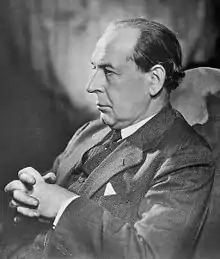
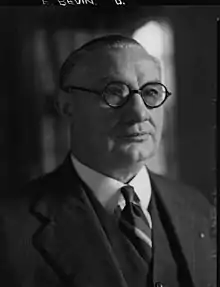
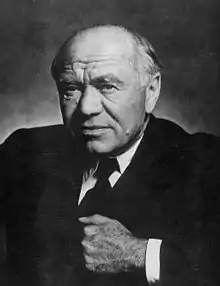
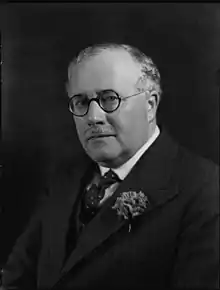
.jpg.webp)

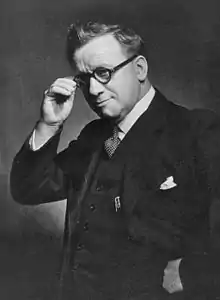
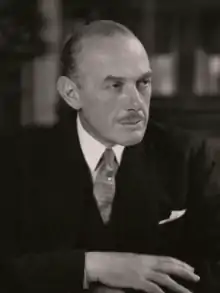
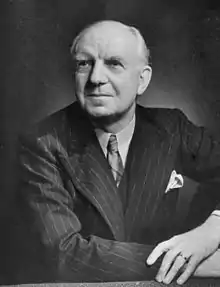
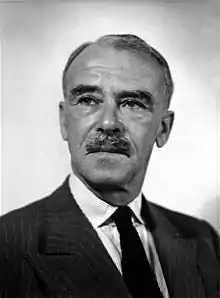



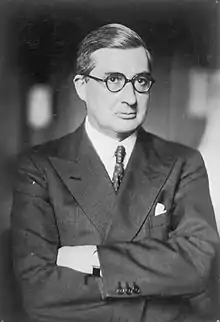

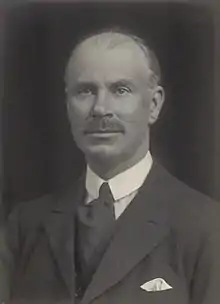
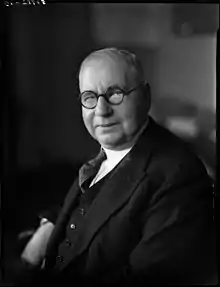
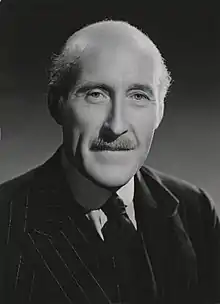
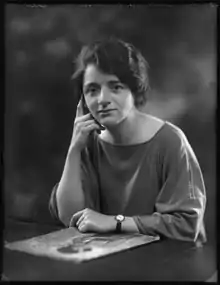
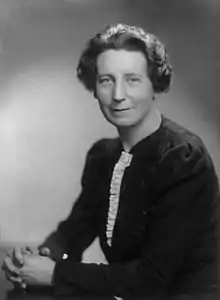
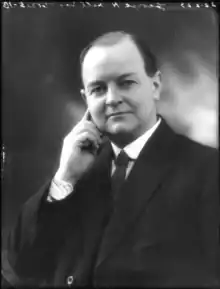
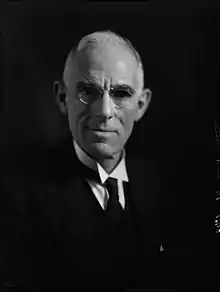
.svg.png.webp)